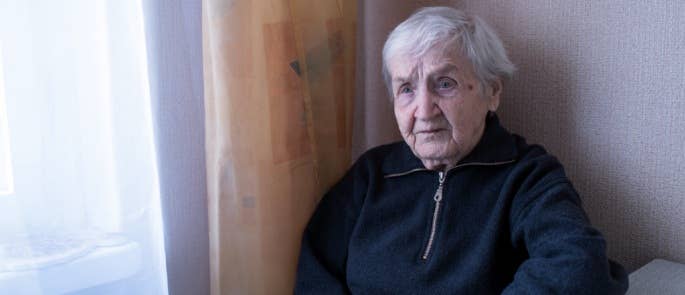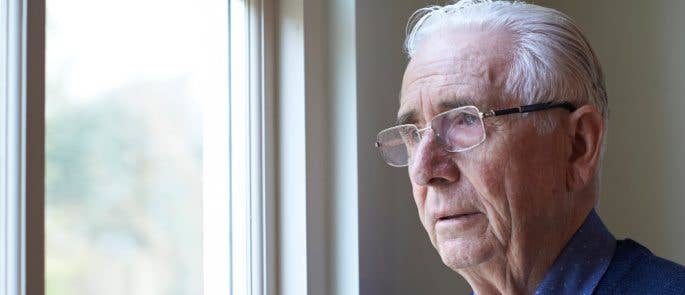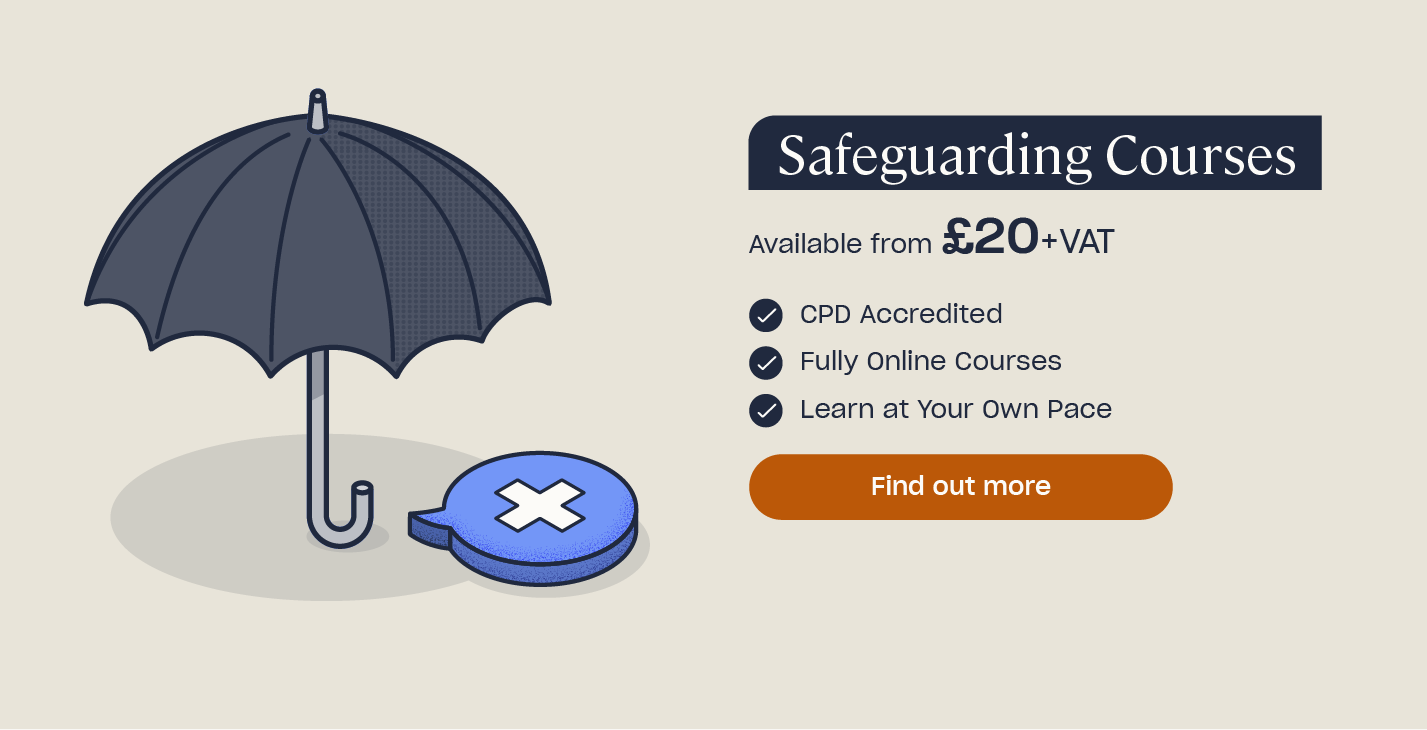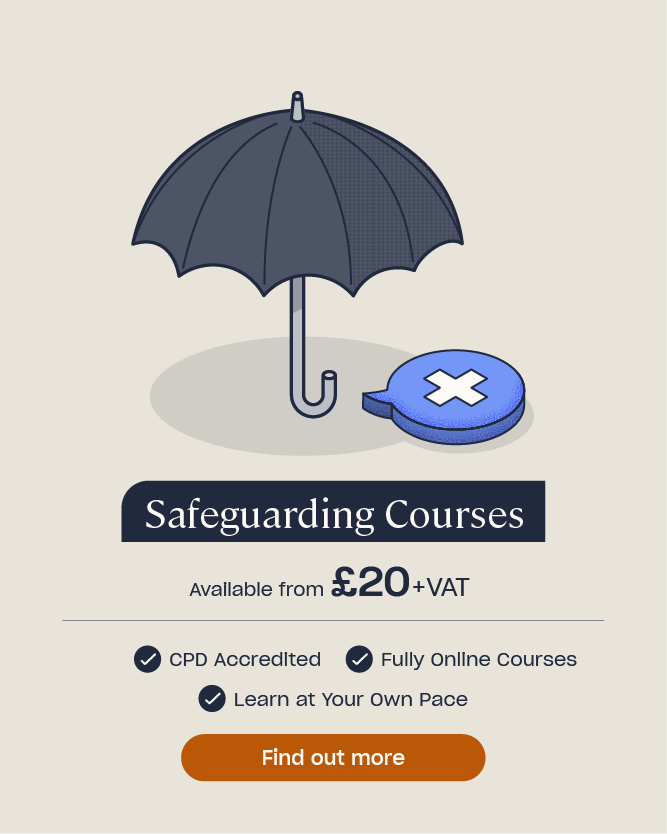Signs of Abuse in Adults
Data published by NHS Digital reports that 475,560 concerns of abuse for adults were raised during 2019-20. This was a 14.6% increase on the previous year. Neglect and acts of omission made up the largest number of concerns raised, with 31.8% of all concerns falling within this category.
This number is worryingly high already, but what’s worse is that the actual number will likely be much higher as a large number of cases go unreported. This might be because the abuser is skilled at hiding their abuse, the victim is too fearful or cannot speak out about their abuse (for example, if they have had a stroke that resulted in communication difficulties), or the victim lacks the capacity to understand that what they are experiencing is abuse. As a result, if you work with adults, it’s crucial that you are aware of the signs that may indicate an adult is being abused.
Types of Adult Abuse
Abuse or neglect can be categorised depending on their type. While there are many different types, the Care Act 2014 provides ten categories that adult abuse may form part of:
- Physical abuse
- Domestic violence
- Psychological abuse
- Sexual abuse
- Financial or material abuse
- Modern slavery
- Discriminatory abuse
- Organisational abuse
- Neglect and acts of omission
- Self-neglect
Many instances of abuse often co-exist; for example, an adult who is being domestically abused may also be suffering from psychological and sexual abuse.
Abuse may be a one-off occurrence or multiple incidents, and one person may be affected or it may form part of a wider pattern of harm – for example, if organisational abuse affects all service users in an organisation. Exploitation is a type of abuse that forms part of this: those who are criminally exploited may unknowingly be part of a much wider criminal network.
Anybody may fall victim to abuse, with all adults (those aged 18 and over) potentially being affected. However, there are some situations that put an adult at increased risk of harm. For example, people with particular care and support needs, such as dementia or a learning disability, may struggle to communicate what is happening to them, or their communication may be misinterpreted as a symptom of their condition. Sadly, abusers target these adults knowing this. This is why it’s so crucial for you to know the signs.

Signs of Physical Abuse in Adults
Physical abuse is any deliberate act of force against a person that results in physical harm, injury or trauma. This includes hitting, kicking, burning, scalding, biting, or pushing. It also
includes the misuse of medication, forced feeding or withholding of food, and incorrect use of restrictive practices – where there is unauthorised use of restraint against an individual or unwarranted confinement.
Signs of physical abuse are often evident, although they may be well hidden by the abuser. The victim may also hide any physical evidence: they may love the perpetrator and not want to get them into trouble, or be too fearful to speak out or be questioned on it. Potential indicators of physical abuse include:
- Broken bones, bruises, marks on the body, or bite, burn or scald marks.
- Frequent injuries that are unexplained or inconsistent with the account of what happened.
- Unexplained falls.
- Signs of malnutrition.
- Missed medical appointments or medical conditions left untreated.
Signs of Domestic Abuse in Adults
Domestic abuse is abuse between two people who are over the age of 16 and who are, or have been, intimate partners or family members. It encompasses controlling, coercive or threatening behaviour and violence.
This type of abuse can include lots of other types of abuse, including physical, psychological, sexual, and financial, as well as ‘honour-based’ abuse such as forced marriage. As a result, you may be able to detect domestic abuse through the indicators of other types of abuse. This includes:
- Physical indicators, such as bruising or broken bones.
- Psychological indicators, such as being isolated from friends or family, low self-esteem, blaming themselves for things (including their abuse), and humiliation in front of others.
- Financial indicators, such as limited access to money and damage to the home or other property, such as cars.
Coercive control is a core aspect of domestic abuse. This is any behaviour designed to control an individual, and includes behaviours such as regulating behaviour, punishing or frightening someone, isolating them, exploiting their resources or money, or assaulting, threatening, humiliating or intimidating them.
Signs of Psychological Abuse in Adults
Psychological (also referred to as emotional) abuse is any type of behaviour that involves emotional mistreatment of a person. It includes threats of harm or abandonment, enforced social isolation (such as preventing someone from seeing their family or accessing external services, like education), not respecting privacy, intimidating, coercing or threatening someone, cyber-bullying, or preventing someone from meeting their religious and cultural needs, their expression of choice and opinion, or meaningful activities and stimulation. In relationships, psychological abuse can also include harassing partners about imagined affairs or other false claims.
Signs of psychological abuse include:
- Low self-esteem, or withdrawal or change in the emotional state of the person.
- Changes in appetite, or weight loss or gain.
- Insomnia.
- Tearfulness and other signs of distress, including anger in some cases.
- Fearfulness or silence when a particular person is around.

Signs of Sexual Abuse in Adults
Sexual abuse is where an individual is forced, pressured or tricked into taking part in sexual activity with another person. The person may have expressed that they didn’t want to be involved, may not be able to give consent or may not have the capacity to understand what is happening.
Sexual abuse includes rape, indecent exposure, inappropriate looking or touching, sexual harassment, teasing or innuendo, sexual photography or subjection to pornography or witnessing sexual acts that the adult has not consented to or was pressured into consenting to. Sexual abuse can occur in relationships – for example, if somebody rapes their partner or regulates their access to birth control.
Signs of sexual abuse include:
- Bleeding, pain, itching or sores around the genitals.
- Pain or discomfort when walking or sitting.
- Bruising, especially on the thighs, buttocks, upper arms and neck.
- Torn, blooded or stained clothing (e.g. from discharge).
- STIs, unexplained genital discharge or incontinence that is unrelated to a medical diagnosis.
- Unexplained pregnancy, for example in a woman who is unable to consent to intercourse.
- Sleeping difficulties, self-harm, withdrawal, poor concentration, apprehension about relationships, or reluctance to be left alone with a certain person.
- Not wanting to receive help with personal care.
- Explicit use of sexual language or changes in attitude and behaviour towards sexual activity.
Signs of Financial or Material Abuse in Adults
Financial or material abuse involves someone using or misusing money to control a person’s actions and their freedom, and using their funds or belongings without their permission. Types of financial abuse include scams (both online and in-person), theft, fraud, coercion of an adult for their financial affairs or arrangements – such as their will, property or inheritance – or the misuse or misappropriation of property, possessions or benefits.
Financial or material abuse may present itself in some health and social care environments – for example, misuse of personal allowance in a care home, arranging less care than is needed to ‘save money’ (and then pocketing the difference or maximising inheritance) or denying assistance to access benefits. Additionally, those adults who live alone may be more at risk of scams or rogue trading – where unnecessary, poor-quality or overpriced property repairs are carried out, or fail to be carried out after being paid for.
Signs that may indicate financial or material abuse in adults are:
- Unexplained lack of money, withdrawal of funds from accounts, or misplaced personal possessions.
- Rent arrears or evictions.
- Disparity between the person’s living conditions and their finances.
- People showing an unusual interest in the individual’s finances and assets.
- Changes in the deeds or title to an adult’s property.
- Lack of financial records in a care service.

Signs of Modern Slavery in Adults
Modern slavery is any act of recruitment, movement, harbouring, or receiving of people through the use of force, coercion, abuse of power, deception, or other means, for the purpose of exploitation.
Modern slavery is a very serious and broad category of abuse and encompasses slavery, human trafficking, forced labour and domestic servitude. For victims of modern slavery, their life is completely out of their own control, so being aware of its signs and acting on them is very important.
Signs that an adult may be a victim of modern slavery are very similar to signs of other forms of abuse, often because a person who is victim of modern slavery will experience other types of abuse as well. You should be concerned when a person:
- Appears malnourished or unkempt; for example, they wear the same clothes every day.
- Seems withdrawn, avoids eye contact or appears hesitant or frightened of others.
- Is isolated, rarely being allowed on their own or seemingly being under the control and influence of others.
- Has few, or no, personal possessions.
- Lacks identification documents.
- Lives in poor conditions, such as dirty, cramped, or overcrowded places.
- Fears law enforcement officers.
- Shows signs of physical and psychological abuse.
Signs of Discriminatory Abuse in Adults
Discriminatory abuse occurs when an individual or group is treated unequally because they possess one of the protected characteristics outlined by the Equality Act 2010. These characteristics are age, disability, sex, sexual orientation, gender reassignment, marriage and civil partnership, pregnancy and maternity, race, and religion or belief.
This type of abuse includes derogatory comments, jokes or slurs, denying access to services, hate crime, ignoring someone’s views, unfair treatment, and denying somebody’s rights to healthcare, education or employment because of a protected characteristic. For example, denying access to communication aids (such as an interpreter or lip-reader) because of the religion somebody follows would be discriminatory abuse.
Signs that an adult is experiencing discriminatory abuse include:
- Behavioural changes, including an individual becoming withdrawn, isolated, angry, frustrated, fearful and anxious.
- A lack of support for an individual’s needs. For example, if they need to use a wheelchair but are denied access to ramps.
- An individual beginning to reject their own cultural background, personal beliefs, sexual preferences or lifestyle choices.

Signs of Organisational Abuse in Adults
Organisational abuse is where an organisation prioritises their own needs over those of their service users and people they support. Examples include making all service users in a care home eat dinner at the same time so that kitchen staff can finish earlier, or making all service users go to bed at the same time so that it’s ‘easier’ for staff.
It also includes neglect or poor care practice within an institution or specific care setting, such as no respect for privacy and dignity, discouraging visits, failing to respond to complaints, not promoting choice and independence, and failing to assist with eating where necessary. Organisational abuse may be a result of an organisation’s policies, structures or procedures, or it may be caused by high staff turnover, lack of leadership or supervision, or rigid routines being enforced by management.
Signs of organisational abuse include:
- Rigid routines and a lack of flexibility and choice for service users.
- Lack of staff training, development and support.
- Poor standards of care, including people being hungry or dehydrated.
- Misuse of medication.
- Inadequate staffing levels, procedures and record-keeping.
- Lack of individual care plans.
- Few social, recreational and educational activities, and an absence of visitors.
- Lack of privacy and confidentiality, including public discussion of personal matters, and exposure when somebody is using the toilet or bathing.
Signs of Neglect in Adults
Neglect and acts of omission occur when somebody who has responsibility for the care of an adult fails to provide the amount and type of care that the person requires. For example, not providing adequate food, shelter, clothing, activity, personal or medical care, and aids such as glasses, dentures and hearing aids. It also includes mistreatment, such as delivering care in a way a person dislikes, ignoring or isolating them, and ignoring someone’s specific care needs (including physical, medical, cultural and recreational needs).
Neglect may be a result of deliberate mistreatment, but it may also be an unintended consequence of somebody not having the ability to care for someone. For example, an elderly couple may both reside at their own home and one of them may have dementia. The other person may not be able to provide the level of care that the person with dementia requires and some of their care needs may be neglected. This neglect would be the result of an inability to provide full and appropriate care, rather than deliberate mistreatment.
Signs that an adult may be experiencing neglect include:
- A dirty or unhygienic environment.
- Poor personal hygiene.
- Inadequate clothing.
- Injuries or medical problems untreated, pressure sores or ulcers, or malnutrition or unexplained weight loss.
- Lacking contact with medical or social care organisations.
- Build-up of untaken medication.
Signs of Self-Neglect in Adults
Self-neglect is the name given when an individual fails, or refuses, to take care of their own basic needs. It includes a lack of self-care to the extent that it threatens health and safety; for example, they may hoard things in their home which create a trip hazard, or they may refuse to take their medication which can have detrimental effects on their health.
It also includes not caring for personal hygiene, health or surroundings, an inability to avoid self-harm, failing to seek help from medical services or access services, or an inability or unwillingness to manage their own personal affairs.
There are many reasons for self-neglect – an individual may face difficulties with their mental health, struggle with addiction or lack the mental capacity to care for themselves.
Signs of self-neglect in adults include:
- Poor personal hygiene and an unkempt appearance.
- Lack of essential food, clothing or shelter.
- Poor living conditions, including living in unsanitary conditions, neglecting household maintenance or hoarding.
- Malnutrition and/or dehydration.
- Unwillingness to take medication, treat illnesses or injuries or comply with health or care services.

What Can I Do if I Recognise Abuse?
If you recognise any of these signs, and are concerned an adult is the victim of abuse, then it’s essential you act on your concerns. Failing to act may make the perpetrator think they are getting away with it, and the abuse may escalate or they may begin to target other adults. Speaking out about abuse can even save somebody’s life.
If you think that somebody is being abused, you can firstly talk to them and see if there’s anything you can do to help. Remember that they may not want to talk about it straight away, especially if they have spent a long time hiding it, if they are being coerced or threatened, or if the abuser is someone they know and trust, and even love. Talk to them in private and mention some signs you’ve noticed that concern you. Give the individual a chance to talk as much as they want to.
If they do confide in you about abuse, stay calm and don’t let your shock or emotions show. Do not promise them that you will keep it a secret. Ask them what they would like to do, informing them who they can talk to about their abuse or that you are able to help them and get support on their behalf. Give them time to think about what they want to do – however, if there is an immediate threat to their safety, contact the police without delay.
If somebody wants your help, you can:
- Contact professionals, such as the adult’s GP or social worker (if they have one).
- If you work in an organisation that provides care and support to individuals (such as a care home), speak to your line manager or the person with lead responsibility for safeguarding and report your concerns, following your organisation’s agreed ways of working.
- If the abuse is part of a wider pattern of harm and wrongdoing in your organisation, you could proceed by whistleblowing.
- Contact the individual’s local council – every local authority has a dedicated adult safeguarding team. You can find the details you need for local councils online.
- Speak to the necessary services; if a crime has been committed, the police should be informed, or if somebody is seriously hurt as a result of abuse then you should call for an ambulance.
- Make contact with a dedicated helpline or charity, such as Hourglass (Action on Elder Abuse) or Refuge (for victims of domestic violence) who will be able to help.
At all times, remember to support the adult, reassure them that the abuse was not their fault and you are here to help them, and keep them informed as any inquiries progress.
Remaining vigilant to signs of abuse in adults is extremely important – in some cases it could save an individual’s life. The ten types of abuse often coexist and signs overlap, so it’s possible an adult who is being abused may show many different signs and indicators. Speak to the adult if you have any concerns, and do not delay if they are in immediate danger.
Further Resources:
- Safeguarding Adults Training Courses
- Whistleblowing on Safeguarding Adults: Why is it Important in Healthcare?
- What is the CQC and Why are KLOEs Important in Care?
- Methods of Human Trafficking and Recruitment
- How Can We Work Together to Safeguard Adults?
- Signs of Abuse in Children
- Malnutrition in the Elderly








